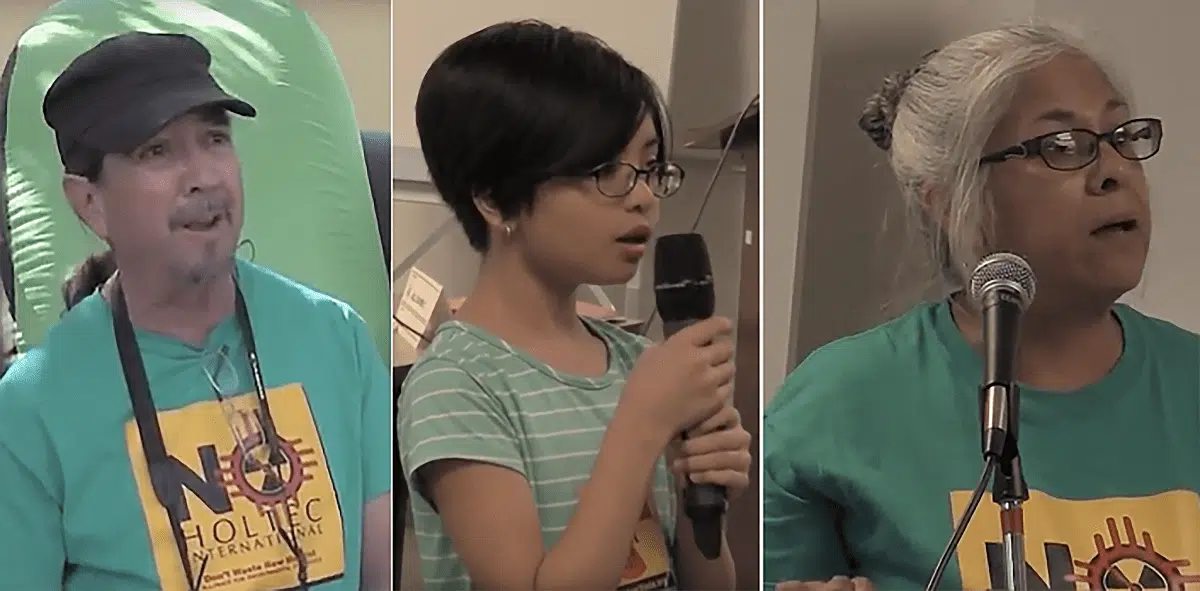People Power on ‘Nuclear Alley’
“I am so sick and tired of all these big companies coming into New Mexico, close to my town in Eunice, wanting to give us all this crap, this crap that could kill us.” Rose Gardner – New Mexico Community Organizer
“Our lands are not the nation’s dumping ground for dangerous high-level waste. It brings cancer, birth defects and deaths. Those who created the waste should take responsibility for it. It would be an extreme environmental and economic injustice for the rest of the nation to dump deadly radioactive waste on New Mexico.” Noel Marquez – New Mexico Mural Artist & Community Organizer
“My name is Pai, and I am 11 years old. I’m here on behalf of unborn kids and born kids like me. I think this whole situation is very important because it affects everything and everybody. It affects the plants and wildlife around them. You may think you might be solving a problem, but really you’re just creating more problems to solve, and they might just be forever. You might just not be able to solve them. “- Pai Marquez

Portraits of Grassroots Resistance
Rose Gardner, Noel Marquez and his daughter Pai are residents of a largely Hispanic region of New Mexico that has come to be known to locals as ‘Nuclear Alley.’
Their plight is featured in the new documentary film SOS – The San Onofre Syndrome: Nuclear Power’s Legacy, which has its world premiere on Sunday, October 8th, 7:30 pm, as the Closing Film of the Awareness Film Festival, at the Regal L.A. Live Theater, 1000 W Olympic Blvd., Los Angeles, CA 90015, followed by a Q&A with the filmmakers and protagonists in attendance. The film’s virtual premiere will take place on Sunday, October 15th, 5 pm on the festival platform, followed by a Q&A with filmmakers. TICKETS Available here.
Located on the southeast corner of the state, Nuclear Alley is home to the Urenco nuclear enrichment plant, the U.S. Nuclear Waste Isolation Project (WIPP) and, just across the Texas border, the company Waste Control Specialists (WCS) offers “comprehensive services for the treatment, storage and disposal of Class A, B and C low-level radioactive wastes.”
On February 14, 2014, a major release of highly dangerous radioactive particles occurred at the WIPP facility, the only underground nuclear waste repository in the U.S., flowing out into the surrounding countryside.
A subsequent year-long investigation by government scientists revealed, according to ArsTechnica.com, that,
“The 2014 explosion apparently occurred when engineers at the Los Alamos National Laboratory were preparing a drum of plutonium and americium waste—usually packed with kitty litter (yes, kitty litter)—and decided to “substitute an organic material for a mineral one.
“’The new material caused a complex chemical reaction that blew the lid off a drum, sending mounds of white, radioactive foam into the air and contaminating 35 percent of the underground area,’ the LA Times wrote. The dump’s filtration system, which was supposed to ‘prevent any radioactive releases,’ subsequently failed.”
It was a stark demonstration of the ineptitude of current radwaste management practices. And a rude reminder that no mistakes can be made in the handling nuclear waste, yet human error is inevitable.
People Power Rising
Rose Gardner is the co-founder of the Alliance for Environmental Strategies, a major force in a groundswell of opposition to a proposal by Holtec International in partnership with a local group calling itself the Eddy-Lea Energy Alliance.
The NRC gave a license to these few businessmen to build a so-called Centralized Interim Storage (CIS) facility along the local county line. If implemented, it would be the world’s largest nuclear waste storage facility and would take all the nation’s high level radioactive waste. Just recently the Fifth Circuit Court ruled that the NRC overstepped its authority and ruled the license invalid. A challenge to the ruling might go to the Supreme Court.
John Heaton, the Chairman of the Eddy-Lea Alliance, articulated the problem:
“The utilities had never anticipated onsite storage, and now a third of the population of the United States lives within 50 miles of a nuclear power plant. That’s 120 million people. We then recognized that we had an ideal site. But in the community itself, what I like to say about us because of WIPP and the numbers of years it took to get it open, we have what I call a very high nuclear IQ in our area of the state.”
But what Heaton termed ‘a high nuclear IQ can cut both ways.
Documenting the Speaking of Truth to Power
We became friends with Mr. Marquez, Pai Marquez and Mrs. Gardner while we were shooting the feature documentary SOS – The San Onofre Syndrome, which will have its World Premiere at Los Angeles’s Awareness Film Festival on Sunday, Oct. 8th at 7:30 PM at the Regal L.A. Live Theatre, 1000 W. Olympic Blvd.
What took us there is that their community is the target of a proposed plan to ship tons of high-level radioactive waste now piling up at Southern California Edison’s shutdown San Onofre Generating Station (SONGs) in San Clemente, California all the way across country through population centers on poorly maintained rail lines, highways and bridges. Their community could become a permanent national nuclear dump in New Mexico because there is no existing central Federal repository.
Rose Gardner explains:
We are located right in the middle of something called the Permian Basin, and the Permian Basin is the richest oil field area in America. But what happened to us is we became this hub of nuclear facilities all of a sudden.
Now we’ve got a competition between a company named Holtec International, and Waste Control Specialists that now wants to do the same thing.
Their proposal is to bring in nuclear waste from around the country, from all the reactor communities and store it in one place, hundreds and thousands of tons of nuclear waste from reactors in the United States.
This is where I’m from. I was born in my godmother’s house. I wasn’t born in a hospital. I was born right here and I’ve got more rights to speak for my community than a whole lot of other people have rights to speak for their little projects.
Gardner’s fellow activist Noel Marquez passed away Dec. 23, 2020 at the age of 67. In the brief time we were honored to know him, we were touched, like all who worked with him, by his open heart and deep commitment to environmental justice, democratic rights and our shared responsibility to future generations.
He was a Good Ancestor in every sense of the words. Noel Marquez won the New Mexico Governor’s Award for Excellence in the Arts for his many murals depicting the plight of the state’s indigenous people and his beloved land.
Noel was also a dedicated and effective community organizer for nuclear safety and indigenous rights. He identified himself as a community artist, small-time farmer and most importantly, the father of his beloved daughter Pai, who had already begun to follow in her father’s activist footsteps of non-violent, democratic resistance.
As Rose Gardner declared as a community representative in an NRC regional conference on the issue, “I’m here to tell Holtec hell no, we don’t want it!”
Eleven-year-old Pai Marquez spoke eloquently in that meeting on behalf of her generation with wisdom beyond her age, as quoted above. When her father took to the podium to do his own truth-telling, Chip Cameron, the NRC meeting manager attempted to cut him off.
Audience outrage brought Marquez back to the microphone to complete his statement.
He talked of his mother’s school experience of being segregated – along with Native American students – to a dilapidated shack behind the Anglo school. And how only the threat of a Federal funding cut forced their access to integrated educational facilities. He made the connection between the experience of his forbearer and the nuclear racism he and his daughter are navigating today.
The New Mexico situation fits the dominant pattern of environmental injustice that targets low income, minority, rural communities with receiving the nation’s most toxic chemical and radiological waste products.
Gardner and her colleagues have good reason to expect that, if once in place, an Eddy-Lea/Holtec CIS facility would become a de facto national dumpsite.
The neighboring Waste Control Specialists (WCS) just across the Texas border originally contracted to receive so-called low level radioactive waste from only Maine and Vermont. In fact, it now currently accepts waste from a total of 34 states.
That is the wake-up call of SOS – The San Onofre Syndrome, a local story with national and international implications.
The Good News is that,
“On August 25, 2023, the U.S. Court of Appeals for the Fifth Circuit vacated the U.S. Nuclear Regulatory Commission (NRC) license granted to Interim Storage Partners, LLC (ISP) for its temporary spent nuclear fuel storage facility in Texas—known as a Consolidated Interim Storage Facility (CISF)—asserting that the NRC did not have the requisite statutory authority under federal law to issue licenses for private parties to store spent nuclear fuel away from the reactor site.” Source
Since this conflicts with other Court of Appeals rulings, the U.S. Supreme Court may decide to take this case under review. Otherwise it will stand as a significant precedent for future CIS legal challenges.
The Nuclear Monitor reports that, “New Mexico has also outlawed storage of spent nuclear fuel in its territory.” So far that law remains unchallenged as of 9-20-2023.
In trend-setter state California, opposition is growing to Governor Gavin Newsom’s nuclear recidivistic push, at the behest of the nuclear industry to extend the operation of PG&E’s aged and dangerous Diablo Canyon reactors. Plans are seriously afoot to legislate a model state-level plan for dealing with radioactive waste in the most ethically, environmentally and technologically method currently available.
As the late visionary artist and activist Noel Marquez concluded in his presentation to the NRC, “We are the protectors of our freedoms and our environment. The ecology is all connected – as my daughter has told. Power to all the people.“
SOS – The San Onofre Syndrome: Nuclear Power’s Legacy Documentary Film
October 8th, 7:30 pm – Closing Film at the Awareness Film Festival followed by Q&A filmmakers & protagonists in attendance. Regal L.A. Live Theatre, 1000 W. Olympic Blvd., Los Angeles, CA 90015
October 15th, 5 pm – Virtual Premiere followed by Q&A with the filmmakers
TICKETS to both events available here. Tickets include access to two short films and the feature film as well as access to the ensuing Reception and Awards ceremony.
For more information, and further screenings please visit SanOnofreSyndrome.com
Mary Beth Brangan and James Heddle are the co-founders of EON, the EcologicalOptionsNetwork.org










